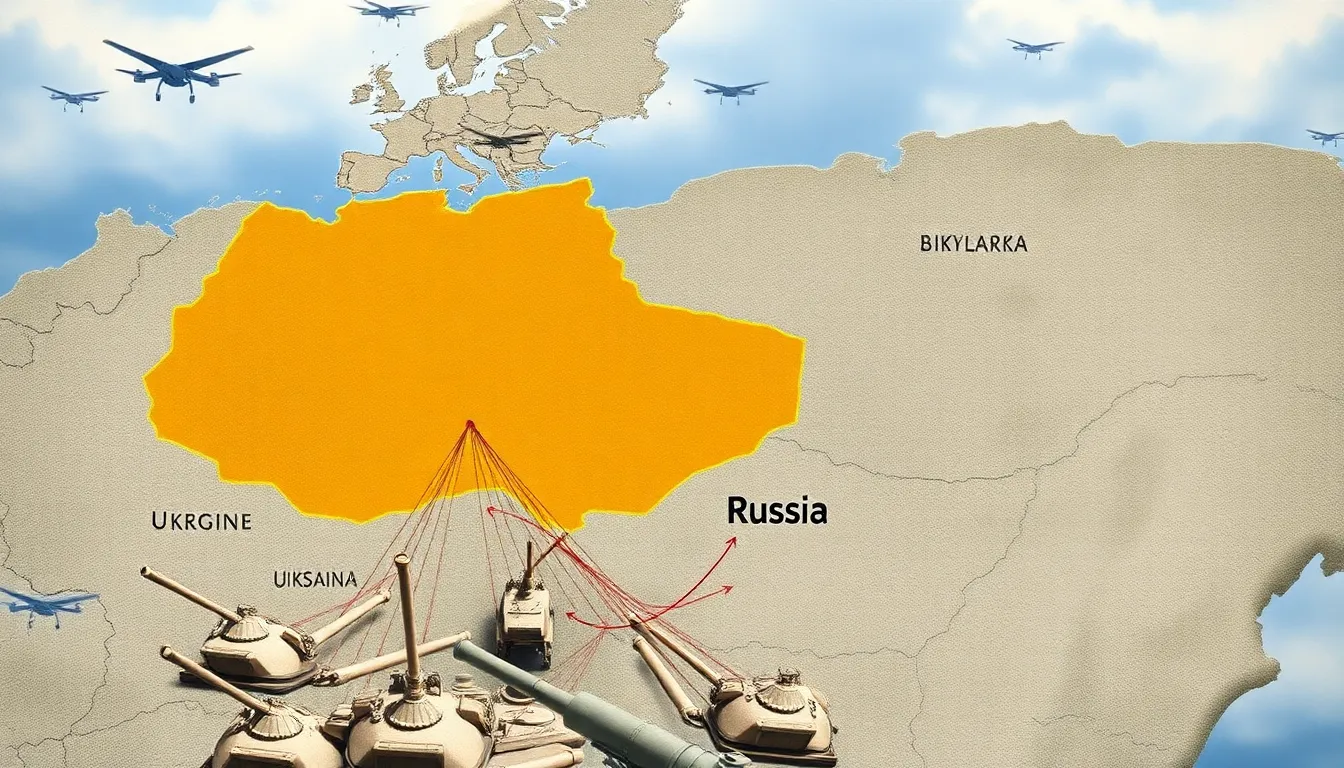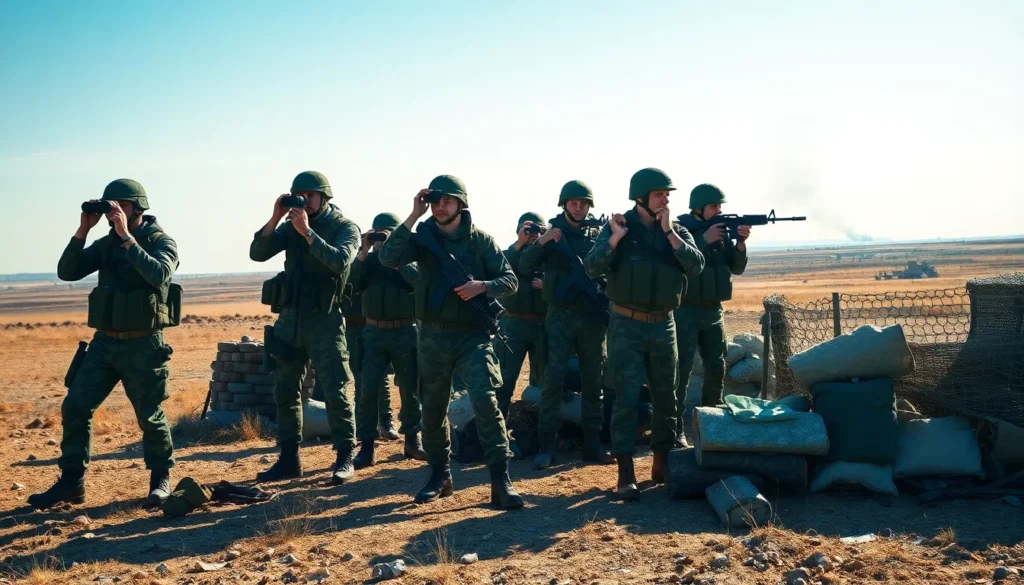As the conflict between Russia and Ukraine continues to evolve, the landscape of international relations grows increasingly complex. By May 2025, this war may take on new dimensions, influencing not just regional stability but also global geopolitical dynamics. With shifting alliances and emerging strategies, the implications of this ongoing struggle are far-reaching.
Analysts and experts are closely monitoring developments, as each decision made by either side could alter the course of history. The potential for escalation or resolution hangs in the balance, making it crucial to understand the factors at play. In this article, we’ll explore the current state of the war, the key players involved, and what the future might hold for both nations and the world at large.
Table of Contents
ToggleOverview of the Russia Ukraine War May 2025
The Russia-Ukraine war continues to evolve, presenting complex challenges as of May 2025. This conflict has led to significant military engagements and shifting territorial control. Analysts note ongoing hostilities, particularly in Eastern Ukraine, where battles over key cities persist.
International response remains crucial. Western nations support Ukraine through military aid, sanctions against Russia, and diplomatic efforts. The United States has reinforced its commitment, while NATO maintains a watchful stance, enhancing presence in Eastern Europe. Conversely, Russia seeks to solidify its territorial gains, employing a mix of military and cyber strategies.
Humanitarian crises unfold from the war, with millions of Ukrainians displaced. Reports indicate that more than 8 million people have sought refuge in neighboring countries, while internal displacement within Ukraine remains high. International organizations strive to provide relief, though access often faces challenges.
Economic consequences impact both nations. Ukraine’s economy struggles due to destruction and loss of resources, while Russia experiences sanctions-induced economic strain. Global markets reflect these tensions, particularly in energy prices, which fluctuated amid uncertainty.
Potential future outcomes hinge on diplomatic negotiations. Key stakeholders might foster peace talks, but lasting resolutions appear distant. The success of ongoing military operations and international diplomatic efforts will dictate the trajectory of this conflict, emphasizing the importance of sustained global attention.
Key Developments

The conflict between Russia and Ukraine continues to evolve, marked by significant military actions and geopolitical maneuvers as of May 2025. Analysts monitor these events closely, as they influence both regional stability and global dynamics.
Military Strategies and Tactics
Military strategies play a crucial role in the ongoing conflict. Ukraine has adopted a hybrid defense approach, combining conventional forces with guerrilla tactics to disrupt Russian advances. Emphasis on drone warfare and artillery has increased, with Ukrainian forces utilizing Western-supplied technology for targeted strikes.
Russia continues to employ a mix of conventional and asymmetric strategies, focusing on artillery bombardments and cyber warfare to weaken Ukrainian defenses. The Kremlin’s integration of advanced weaponry and electronic warfare units aims to disrupt Ukrainian communications and logistics. Control over key urban areas remains a focal point as both sides vie for territorial advantage.
Political Alliances and Support
Political alliances shape the conflict’s landscape. The United States has committed over $75 billion in military assistance to Ukraine since the war’s outset, including advanced weaponry and intelligence support. NATO has increased troop deployments in Eastern Europe, fostering deterrence against potential Russian aggression and reinforcing collective defense.
Ukraine’s diplomatic efforts have garnered support from numerous European nations, leading to heightened sanctions on Russia. The EU has implemented extensive economic measures, impacting Russian energy exports and financial markets. Conversely, Russia seeks to strengthen ties with strategic partners, including China and Belarus, to bolster its position against Western influence. These alliances will influence future negotiations and the potential for conflict escalation.
Humanitarian Impact
The humanitarian impact of the Russia-Ukraine war by May 2025 remains profound and far-reaching, affecting millions of lives and challenging humanitarian efforts.
Displacement and Refugee Crisis
Over 8 million Ukrainians face displacement due to the ongoing conflict, creating one of the largest refugee crises in Europe since World War II. Many have sought asylum in neighboring countries, including Poland and Romania, where local resources strain under the influx. Ukrainian cities and rural areas struggle with internal displacement, complicating access to basic services and support. Humanitarian organizations report that inadequate shelter, food insecurity, and psychological trauma are common among displaced populations. With ongoing violence and instability, many displaced individuals remain vulnerable, unable to return home or secure sustainable livelihoods.
Economic Consequences
The war’s economic consequences are dire for both Ukraine and Russia. Ukraine’s economy, severely impacted by destruction and resource loss, faces a projected decline exceeding 50% since the conflict escalated. Infrastructure damage, particularly in Eastern Ukraine, has disrupted essential services and trade routes. The international sanctions imposed on Russia have led to a forecasted 10% decline in its GDP. High inflation and energy prices continue to affect global markets, complicating recovery efforts. The economic strain exacerbates the humanitarian crisis, limiting resources available for aid and recovery, while challenging donor countries’ commitment to provide ongoing support.
International Reactions
As the Russia-Ukraine war continues to evolve by May 2025, international reactions play a critical role in shaping the conflict’s dynamics. Countries around the world respond with various sanctions and diplomatic initiatives that influence the situation on the ground.
Sanctions and Diplomatic Efforts
Western nations maintain significant sanctions against Russia, targeting key sectors including finance, energy, and defense. The European Union (EU) has imposed multiple rounds of sanctions, restricting exports and preventing access to international financial markets. As of May 2025, the U.S. has added over 1,000 individuals and entities to its sanctions list, focusing on oligarchs and companies linked to the Kremlin. These measures aim to pressure Russia into de-escalating its military actions.
Diplomatic efforts also aim to foster dialogue between Russia and Ukraine. The Organization for Security and Co-operation in Europe (OSCE) engages in monitoring ceasefires and facilitating negotiations. Despite these efforts, meaningful progress remains elusive, as both sides often maintain rigid stances. The ongoing humanitarian crisis underscores the urgency of these diplomatic initiatives, with pressure mounting for renewed peace talks.
Role of Major Powers
Major world powers exert significant influence over the conflict through military, economic, and diplomatic channels. The United States continues to lead the charge among NATO allies, providing military support and coordinating responses to Russia’s actions. As of May 2025, U.S. military assistance tops $75 billion, encompassing advanced weaponry and training programs for Ukrainian forces.
China’s position remains complex, as it seeks to balance its partnership with Russia against broader global interests. China’s recent calls for peaceful resolution on the one hand and its continued economic ties with Russia on the other indicate a strategic approach aimed at maintaining influence in the region. Meanwhile, India maintains a neutral stance, promoting dialogue over aggression, while expanding its trade relations with both sides.
The interplay of these major powers looks set to shape not only the outcome of the conflict but also the future landscape of international relations as diplomatic negotiations continue amidst ongoing hostilities.
Future Implications
The Russia-Ukraine conflict continues to evolve, with substantial implications for the future of international relations. The outcomes of this war could reshape global dynamics significantly.
Potential Resolutions
Ceasefire negotiations could emerge as a potential pathway, contingent upon compromises from both Russia and Ukraine. Diplomatic interventions from entities like the United Nations may encourage dialogue and facilitate agreements on territorial concessions or power-sharing arrangements. If successful, these resolutions could decrease hostilities and foster long-term peace.
Reconstruction efforts may also be pivotal. If nations and global organizations contribute to rebuilding Ukraine, it may strengthen economic ties and encourage political stability in the region. The willingness of the international community to support peacebuilding initiatives may influence post-war relations between the involved parties.
Long-term Effects on Global Politics
The conflict’s outcome will impact global political alliances significantly. If Ukraine achieves closer ties with NATO and the EU, it might shift power balances in Eastern Europe, encouraging other post-Soviet states to seek similar integrations. Conversely, if Russia solidifies its influence over Ukraine, it could embolden authoritarian regimes worldwide, affecting democratic movements in several nations.
Economic repercussions will also shape future relations. If sanctions against Russia persist, countries will reassess their economic dependencies and energy strategies. A shift toward alternative energy sources could emerge to reduce reliance on Russian oil and gas, altering global markets.
Military doctrines may evolve based on lessons learned from this conflict. Nations might reassess their defense strategies, focusing more on hybrid tactics that combine traditional military operations with cyber warfare and unconventional measures.
Overall, the long-term consequences of the Russia-Ukraine war extend beyond the region, influencing geopolitical stability, economic policies, and military strategies globally.
The ongoing conflict between Russia and Ukraine remains a pivotal issue with far-reaching consequences. As May 2025 unfolds the complexities of military strategies and international alliances continue to shape the landscape. The humanitarian crisis deepens while economic repercussions ripple through global markets.
Future developments hinge on diplomatic efforts and the willingness of both sides to engage in negotiations. The potential for a ceasefire and subsequent reconstruction could redefine regional stability. Observers must remain vigilant as the outcomes will likely influence not only Eastern Europe but also the broader geopolitical framework for years to come.






